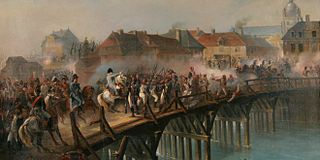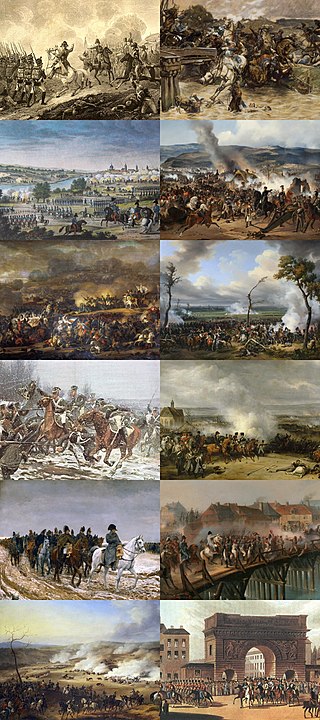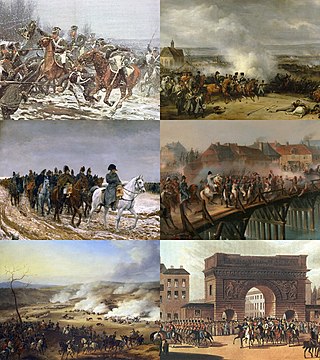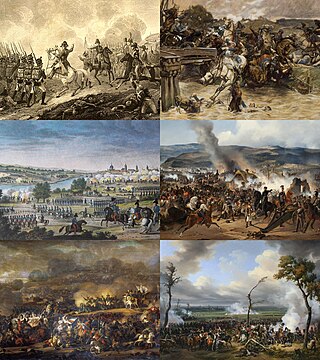
The Battle of Leipzig, also known as the Battle of the Nations, was fought from 16 to 19 October 1813 at Leipzig, Saxony. The Coalition armies of Austria, Prussia, Sweden, and Russia, led by Tsar Alexander I and Karl von Schwarzenberg, decisively defeated the Grande Armée of French Emperor Napoleon Bonaparte. Napoleon's army also contained Polish and Italian troops, as well as Germans from the Confederation of the Rhine. The battle was the culmination of the German Campaign of 1813 and involved 560,000 soldiers, 2,200 artillery pieces, the expenditure of 400,000 rounds of artillery ammunition, and 133,000 casualties, making it the largest battle of the Napoleonic Wars, and the largest battle in Europe prior to World War I.

The Battle of Arcis-sur-Aube saw an Imperial French army under Napoleon face a much larger Allied army led by Karl Philipp, Prince of Schwarzenberg during the War of the Sixth Coalition. On the second day of fighting, Emperor Napoleon suddenly realized he was massively outnumbered, and immediately ordered a masked retreat. By the time the Austrian Field Marshal Schwarzenberg realized Napoleon was retreating, most of the French had already disengaged and the Allied pursuit afterwards failed to prevent the remaining French army from safely withdrawing to the north. This was Napoleon's penultimate battle before his abdication and exile to Elba, the last being the Battle of Saint-Dizier.

The Battle of Brienne saw an Imperial French army led by Emperor Napoleon attack Prussian and Russian forces commanded by Prussian Field Marshal Gebhard Leberecht von Blücher. After heavy fighting that went on into the night, the French seized a château, nearly capturing Blücher. However, the French were unable to dislodge the Russians from the town of Brienne-le-Château. Napoleon himself, making his first appearance on a battlefield in 1814, was also nearly captured. Very early the next morning, Blücher's troops quietly abandoned the town and retreated to the south, conceding the field to the French.

The Battle of Craonne was a battle between an Imperial French army under Emperor Napoleon I opposing a combined army of Imperial Russians and Prussians led by Prussian Field Marshal Gebhard Leberecht von Blücher. The War of the Sixth Coalition engagement began when the bulk of Napoleon's army tried to drive Mikhail Semyonovich Vorontsov's 22,000 Russians off the Chemin des Dames plateau to the west of Craonne. After a bitter struggle, Napoleon's attacks compelled Vorontsov's force to withdraw, but French casualties exceeded Russian losses. While the battle raged, Blücher's attempt to turn Napoleon's east flank ended in failure due to poor planning.

The Battle of Dresden was a major engagement of the Napoleonic Wars. The battle took place around the city of Dresden in modern-day Germany. With the recent addition of Austria, the Sixth Coalition felt emboldened in their quest to expel the French from Central Europe. Despite being heavily outnumbered, French forces under Napoleon scored a victory against the Army of Bohemia led by Generalissimo Karl von Schwarzenberg. However, Napoleon's victory did not lead to the collapse of the coalition, and the weather and the uncommitted Russian reserves who formed an effective rear-guard precluded a major pursuit. Three days after the battle, the Allies surrounded and destroyed a French corps advancing into their line of withdrawal at the Battle of Kulm.

The Battle of Mormant was fought during the War of the Sixth Coalition between an Imperial French army under Emperor Napoleon I and a division of Russians under Count Peter Petrovich Pahlen near the town of Mormant, some 50 km (31 mi) southeast of Paris. Pahlen's outnumbered force was enveloped by cavalry and infantry, and nearly destroyed, with only about a third of its soldiers escaping.

The Hundred Days, also known as the War of the Seventh Coalition, marked the period between Napoleon's return from eleven months of exile on the island of Elba to Paris on 20 March 1815 and the second restoration of King Louis XVIII on 8 July 1815. This period saw the War of the Seventh Coalition, and includes the Waterloo Campaign, the Neapolitan War as well as several other minor campaigns. The phrase les Cent Jours was first used by the prefect of Paris, Gaspard, comte de Chabrol, in his speech welcoming the king back to Paris on 8 July.

In the War of the Sixth Coalition, sometimes known in Germany as the Wars of Liberation, a coalition of Austria, Prussia, Russia, Spain, Great Britain, Portugal, Sweden, Sardinia, and a number of German States defeated France and drove Napoleon into exile on Elba. After the disastrous French invasion of Russia of 1812 in which they had been forced to support France, Prussia and Austria joined Russia, the United Kingdom, Sweden, and Portugal, and the rebels in Spain who were already at war with France.

The Six Days Campaign was a final series of victories by the forces of Napoleon I of France as the Sixth Coalition closed in on Paris.

The Battle of Paris was fought on 30–31 March 1814 between the Sixth Coalition, consisting of Russia, Austria, and Prussia, and the French Empire. After a day of fighting in the suburbs of Paris, the French surrendered on 31 March, ending the War of the Sixth Coalition and forcing Emperor Napoleon to abdicate and go into exile.

The Battle of Château-Thierry saw the Imperial French army commanded by Emperor Napoleon attempt to destroy a Prussian corps led by Ludwig Yorck von Wartenburg and an Imperial Russian corps under Fabian Wilhelm von Osten-Sacken. The two Allied corps managed to escape across the Marne River, but suffered considerably heavier losses than the pursuing French. This action occurred during the Six Days' Campaign, a series of victories that Napoleon won over Prussian Field Marshal Gebhard Leberecht von Blücher's Army of Silesia. Château-Thierry lies about 75 kilometres (47 mi) northeast of Paris.

The Battle of Laon was the victory of Blücher's Prussian army over Napoleon's French army near Laon. During the Battle of Craonne on 7 March, Blücher's army was forced to retreat into Laon after a failed attempt to halt Napoleon's east flank. Along the way to Laon, reinforcements from Russian forces under Ferdinand von Wintzingerode and a Prussian corps led by Friedrich Wilhelm Freiherr von Bülow joined the defensive. Blücher opted to face Napoleon at Laon because it was the site of a strategically important road junction, and because of its highly defensible position.

The Battle of La Rothière was fought on 1 February 1814 between the French Empire and allied army of Austria, Prussia, Russia, and German States previously allied with France. The French were led by Emperor Napoleon and the coalition army was under the command of Gebhard Leberecht von Blücher. The battle took place in severe weather conditions. The French were defeated but managed to hold until they could retreat under cover of darkness.

The Battle of Bar-sur-Aube was fought on 27 February 1814, between the First French Empire and the Austrian Empire. French forces were led by Jacques MacDonald, while the Austrians and their Bavarian allies, forming the Army of Bohemia, were led by Karl Philipp Fürst zu Schwarzenberg. The Austrians were victorious.

The Battle of Fère-Champenoise was fought between two Imperial French corps led by Marshals Auguste de Marmont and Édouard Mortier, duc de Trévise and a larger Coalition force composed of cavalry from the Austrian Empire, Kingdom of Prussia, Kingdom of Württemberg, and Russian Empire. Caught by surprise by Field Marshal Karl Philipp, Prince of Schwarzenberg's main Coalition army, the forces under Marmont and Mortier were steadily driven back and finally completely routed by aggressive Allied horsemen and gunners, suffering heavy casualties and the loss of most of their artillery. Two divisions of French National Guards under Michel-Marie Pacthod escorting a nearby convoy were also attacked and wiped out in the Battle of Bannes. The battleground was near the town Fère-Champenoise located 40 kilometres (25 mi) southwest of Châlons-en-Champagne.

The 1814 campaign in north-east France was Napoleon's final campaign of the War of the Sixth Coalition. Following their victory at Leipzig in 1813, the Austrian, Prussian, Russian, and other German armies of the Sixth Coalition invaded France. Despite the disproportionate forces in favour of the Coalition, Napoleon managed to inflict several defeats, the Six Days' Campaign being the most well-known. However, the campaign ended in total defeat for Napoleon as the Coalition kept advancing towards Paris as Napoleon was out of position to defend the capital, which capitulated in late March 1814. When Napoleon proposed the army march on Paris, his Marshals decided to unanimously overrule Napoleon in order to save the city from further destruction. As a result, the victorious Coalition negotiated the Treaty of Paris, under which Napoleon was exiled to the island of Elba and the borders of France were returned to where they had been in 1792.

The German campaign was fought in 1813. Members of the Sixth Coalition, including the German states of Austria and Prussia, plus Russia and Sweden, fought a series of battles in Germany against the French Emperor Napoleon, his marshals, and the armies of the Confederation of the Rhine - an alliance of most of the other German states - which ended the domination of the First French Empire.
The VI Cavalry Corps of the Grande Armée was a French military unit that had an ephemeral existence during the Napoleonic Wars. The corps was created on 9 February 1814 and General François Étienne de Kellermann was appointed as its commander. The corps was formed by combining a newly arrived dragoon division from the Spanish front, a second dragoon division, and a light cavalry division made up of hussars and Chasseurs-à-Cheval. The latter two divisions included units from the former III Cavalry Corps. Kellermann led the VI Cavalry Corps at Mormant, Troyes, Bar-sur-Aube, Laubressel, and Saint-Dizier. After Emperor Napoleon Bonaparte abdicated in early April, the corps ceased to exist.

The Battle of Gué-à-Tresmes was fought between 14,500 French troops led by Marshals Auguste de Marmont and Édouard Mortier and 12,000 Prussians commanded by Friedrich Graf Kleist von Nollendorf and Friedrich von Katzler. On 28 February the French attacked and drove the Prussians to the north along the west bank of the river Ourcq. That evening and the next day Kleist tried to push the French back while Russian units under Peter Mikhailovich Kaptzevich tried to cross from the east to the west bank of the Ourcq; the Allies were unsuccessful. Gué-à-Tresmes is located where Route D405 crosses the Thérouanne stream about 10 kilometres (6.2 mi) northeast of Meaux.

The Battle of Laubressel saw the main Allied army of Field Marshal Karl Philipp, Prince of Schwarzenberg mount a three-pronged converging attack on the weaker army of Marshal Jacques MacDonald. The French forces under Marshal Nicolas Oudinot bore the brunt of the fighting, in which the Allies tried to turn their left flank. The French abandoned Troyes and retreated west as a result of the action. The village of Laubressel is located 10 kilometres (6 mi) east of Troyes.





















